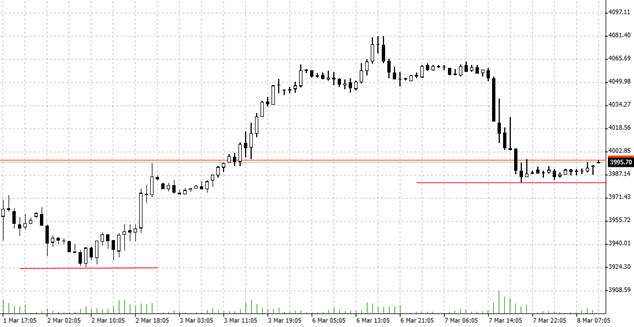

08.03.2023 – Jerome Powell has spoken again. And before the U.S. Congress, he again announced higher interest rates in his usual oracular manner. The Wall Street Journal interpreted it this way: The Fed is ready to accelerate the pace of rate hikes, he said. Powell had opened the door for a larger interest rate step of half a percentage point still this month. Other analysts were also increasingly bearish again.
In fact, the Federal Reserve chief gave some hints that rates will continue to rise higher because recent economic data was stronger than previously expected. The S&P 500 – here the hourly chart – reacted with a setback to around 4,000 points; further down, the zone at 3,900 becomes interesting, more on that in a moment. The financial blog “ZeroHedge” commented that the reason for the market development was a repricing in the terminal rate – investors now expected a final interest rate of 5.63 percent, which is 16 basis points higher than now.

Source: Bernstein Bank GmbH
John Flood, trader at Goldman Sachs wrote this, “Powell said the U.S. central bank is prepared to increase the pace of hikes if data warrant, and sees the ultimate peak Fed rate likely to be higher than expected. In prepared testimony before the Senate Banking Committee, he said the process of getting inflation back to 2% “has a long way to go and is likely to be bumpy.”
Chief economist Michael Feroli of JPMorgan commented that Powell’s words had jeopardized the Fed’s credibility. Specifically, “whereas the plan prior to that data round was to hike by 25bps until there was more evidence of disinflation, Chair Powell indicated today that they are prepared to throw out that playbook if the February data don’t reverse some of the January strength.” A small turnaround, which irritates investors.
Important data and the Fed is silent
But that’s not all – the confusion is likely to increase. Colleague Andrew Tyler, the Head of Market Research at JPM, judged that the Fed “will heavily depend on near-term data for upcoming rates decisions. With January’s macro data mostly printing on the hawkish side, NFP Friday and CPI next Tuesday are the most critical catalysts for Fed’s decision between 25bp and 50bp. Keep in mind that the Fed will start its blackout period this Saturday so CPI will be released during the blackout period, so data itself will be more impactful in absence of guidance from Fedspeeches.” In other words, the coming days could be interesting because some important data is coming in and Fed officials cannot comment during the blackout period. So the market will have to find its own way without guidance.
SPX before the crucial zone
Meanwhile, ultra-bearish market technician Jason Hunter also spoke out, also from JPMorgan. He believes Powell’s speech could push the market lower. Specifically, “The S&P 500 Index slides to retest the key confluence of levels near 3900 after rejecting 4060-4089 tactical pattern resistance. We believe a break through the 3900 inflection can lead to accelerated selling pressure, as that area has acted as a bifurcation for the index from May 2022. It also currently aligns with several trend-following trigger levels for momentum-based strategies. We see the 3760-3764 area as an initial target for a breakdown.”
So that’s the bottom line: Powell could send the SPX through the key support of 3,900 and into the important zone of around 3,760 points. So traders should keep an eye on these marks. Whether long or short – Bernstein Bank wishes successful trades and investments!
___________________________________________________________________________________________________________________________________
The content of this publication is for general information purposes only. In this context, it is neither an individual investment recommendation or advice nor an offer to purchase or sell securities or other financial products. The content in question and all the information contained therein do not in any way replace individual investor- or investment-oriented advice. No reliable forecast or indication for the future is possible with respect to any presentation or information on the present or past performance of the relevant underlying assets. All information and data presented in this publication are based on reliable sources. However, Bernstein Bank does not guarantee that the information and data contained in this publication is up-to-date, correct and complete. Securities traded on the financial markets are subject to price fluctuations. A contract for difference (CFD) is also a financial instrument with leverage effect. Against this backdrop, CFD trading involves a high risk up to the point of total loss and may not be suitable for all investors. Therefore, make sure that you have fully understood all the correlating risks. If necessary, ask for independent advice. CFDs are complex instruments and are associated with the high risk of losing money quickly because of the leverage effect. 68% of retail investor accounts lose money trading CFD with this provider. You should consider whether you understand how CFD work and whether you can afford to take the high risk of losing your money.7
